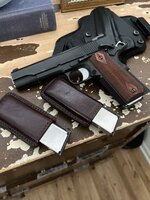- Messages
- 73
- Reactions
- 151
Good evening folks -
Hoping someone more versed in 1911s or non-captured recoil systems can answer my question. Today I replaced my recoil spring in my Dan Wesson Valor 45 ACP with a Wilson Combat 18.5 lb spring, per Dan Wesson's OEM requirement (though the guns come with Wolff 18.5 lb from factory). I had crossed over 2,500 rounds on the original spring and figured it would be a good time to replace it. I never experienced a malfunction in those initial 2,500 rounds.
Upon removing the spring from the package and comparing it to the one in the gun, I noticed there was at least a full inch difference in length between the two with the new one being longer. The slide was much stiffer to rack with the new spring upon install. I installed the new spring and shot about 200 rounds on it and experienced 5 failures, the first ever on this gun. 3 FTF during strings of fire (with one last round somehow popping out of the magazine and just laying in the pre-chamber area causing the jam) and 2 Failure-to-load with a fresh fully loaded mag inserted into slide lock.
The gun had a thin film of oil, and a slight excess was weeping out of the rear rails so I don't think it was a lubrication problem. The more I shot, the smoother the gun seemed to operate (racking the slide back required less force) and in fact most of the malfunctions occurred early in the spring swap upon reflection.The last 50 or so was malfunction free.
Upon removing the new spring from the gun and comparing to the old while cleaning after range session, I noticed that the new spring had compressed to within 1/4-1/2" of the original. To my eyes, it had taken a significant set from the course of fire and now more closely matched the original spring.
My question to those wise in the 1911 way is this: Is it normal/possible that a fresh spring will require a break-in period for the spring to "set" and return the gun to its original 100% reliability and function? Or does this spring swap with subsequent failures unmask a deeper mechanical issue?
Feeling kind of blue since these were my first malfunctions with this 1911 and indeed the first non-break-in malfunctions across all my 1911s that have collectively over 10,000 rounds down range.
Thanks in advance for the help.

Hoping someone more versed in 1911s or non-captured recoil systems can answer my question. Today I replaced my recoil spring in my Dan Wesson Valor 45 ACP with a Wilson Combat 18.5 lb spring, per Dan Wesson's OEM requirement (though the guns come with Wolff 18.5 lb from factory). I had crossed over 2,500 rounds on the original spring and figured it would be a good time to replace it. I never experienced a malfunction in those initial 2,500 rounds.
Upon removing the spring from the package and comparing it to the one in the gun, I noticed there was at least a full inch difference in length between the two with the new one being longer. The slide was much stiffer to rack with the new spring upon install. I installed the new spring and shot about 200 rounds on it and experienced 5 failures, the first ever on this gun. 3 FTF during strings of fire (with one last round somehow popping out of the magazine and just laying in the pre-chamber area causing the jam) and 2 Failure-to-load with a fresh fully loaded mag inserted into slide lock.
The gun had a thin film of oil, and a slight excess was weeping out of the rear rails so I don't think it was a lubrication problem. The more I shot, the smoother the gun seemed to operate (racking the slide back required less force) and in fact most of the malfunctions occurred early in the spring swap upon reflection.The last 50 or so was malfunction free.
Upon removing the new spring from the gun and comparing to the old while cleaning after range session, I noticed that the new spring had compressed to within 1/4-1/2" of the original. To my eyes, it had taken a significant set from the course of fire and now more closely matched the original spring.
My question to those wise in the 1911 way is this: Is it normal/possible that a fresh spring will require a break-in period for the spring to "set" and return the gun to its original 100% reliability and function? Or does this spring swap with subsequent failures unmask a deeper mechanical issue?
Feeling kind of blue since these were my first malfunctions with this 1911 and indeed the first non-break-in malfunctions across all my 1911s that have collectively over 10,000 rounds down range.
Thanks in advance for the help.












